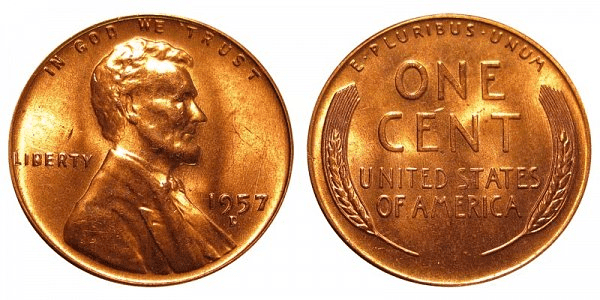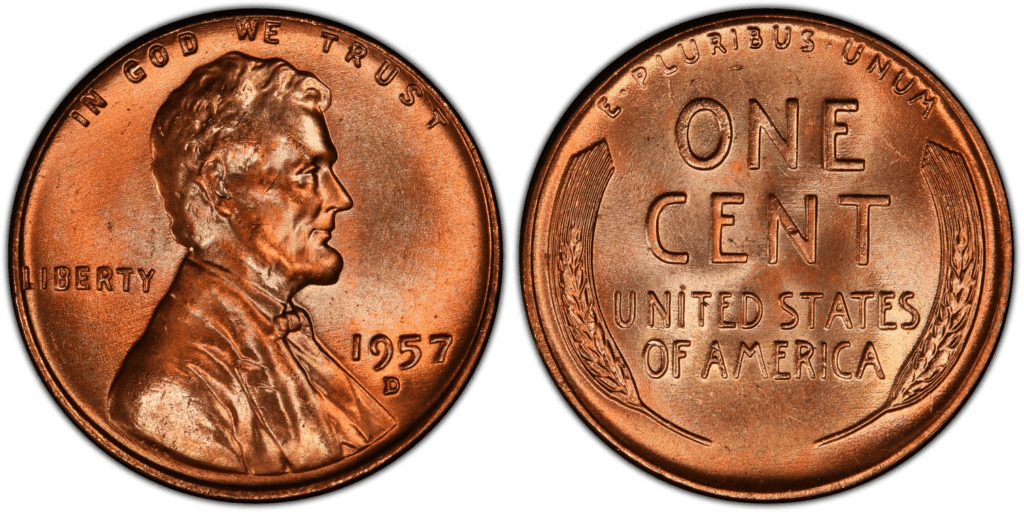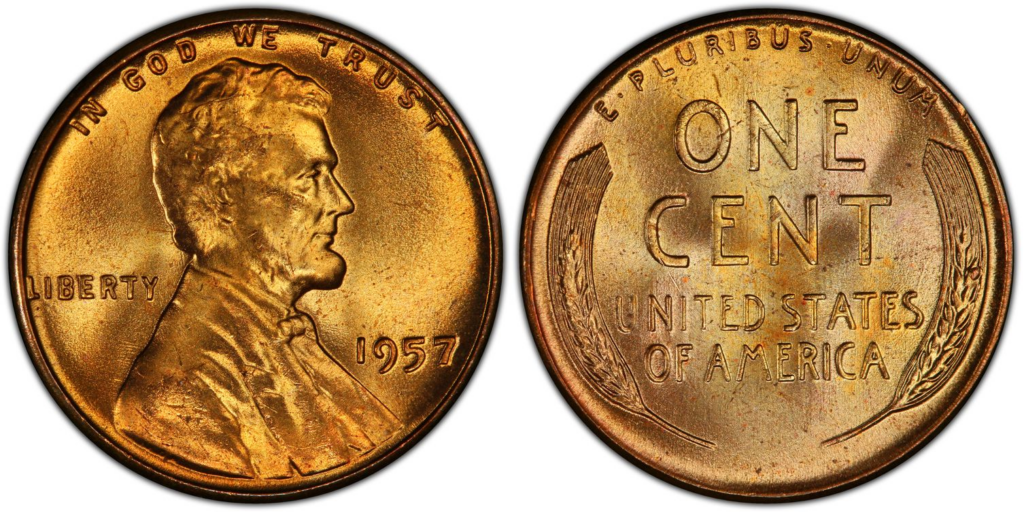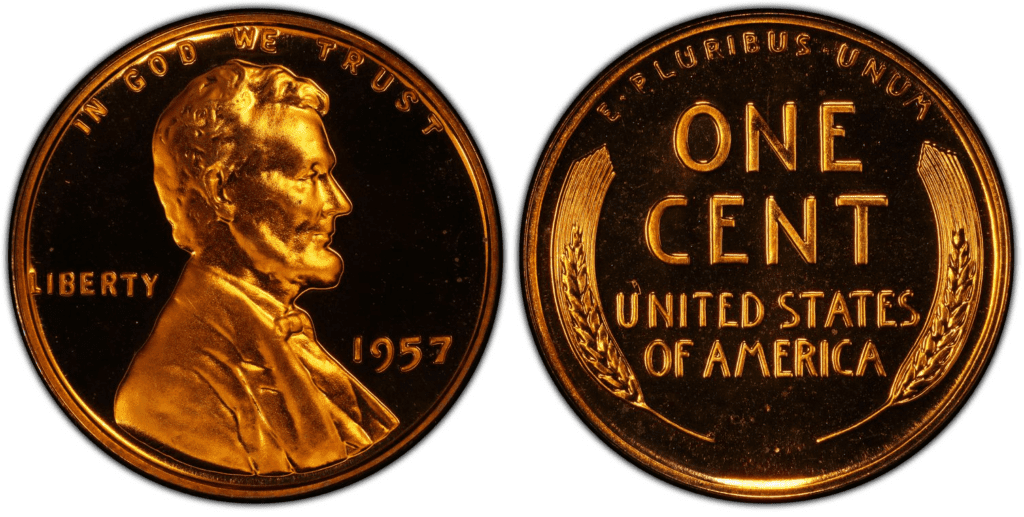What Is the 1957 Lincoln Penny Made Of?
More than six decades ago, the 1957 Lincoln penny was issued by the US Mint. Thus, it is not surprising that there are 1957 Lincoln pennies today worth hundreds and even thousands of dollars.
Looking at its composition, the 1957 Lincoln penny is made of 95% copper and a 5% mixture of tin and zinc. The exact composition was used for pennies minted from 1909 to 1942 and 1944 to 1982.
Nevertheless, the pennies also had other types of compositions in the past. For example, in 1943, the penny was made of zinc-plated steel. The US Mint needed to change the penny composition because copper was a strategic raw material needed during World War I.
From 1982 until now, the penny was turned into 97.5% zinc and 2.5% copper.

For the obverse design, the coin features the 16th president of the United States, Abraham Lincoln. Interestingly, the Lincoln penny was first issued in 1909, the same year Lincoln would have celebrated his 100th birthday.
The inscriptions on the obverse side of the 1957 coin include the following:
- IN GOD WE TRUST
- LIBERTY
- 1957
On the reverse, you’ll see two stalks of wheat engraved on the left and right sides. Inscriptions include E PLURIBUS UNUM, ONE CENT, and UNITED STATES OF AMERICA.
The designer of the original penny was Victor David Brenner. However, did you know that he wasn’t supposed to be the designer of the penny?
Initially, the sculptor Augustus Saint-Gaudens was commissioned to design the 1909 penny. Sadly, he died before completing the project.
When the penny was first struck in 1909, the reverse featured two stalks of wheat. That’s why the penny at that time was commonly referred to as the “wheat penny.” From 1909 to 1958, the penny featured this obverse design. Then, in 1959, the reverse was redesigned to feature the Lincoln Monument.
1957 Lincoln Penny Varieties
The 1957 Lincoln penny varieties include three original designs. These are the 1957 P, 1957 D, and 1957-proof pennies. Aside from the standard struck pennies, some error coins sporadically appear due to minting errors.
Here are the 1957 Lincoln penny varieties you should know:
1957 D Lincoln Penny
Year of minting: 1957
Mint Mark: D
Place of minting: Denver
Quantity produced: 1,051,342,000
Face Value: $0.01 (one cent)
Price: $0.01 to $17.00 (or more)
Mass: 3.11 grams
Edge: Plain
Designer: Victor D. Brenner (obverse)
Composition: 95% copper and 5% zinc
Diameter: 19.05 mm
Thickness: 1.52 mm

The Denver Mint produced more than 1.05 billion 1957 D pennies, the highest mintage for this penny series. The price range of the 1959 D penny is $0.01 to $17.00.
As you can see, there are more than a billion 1957 D pennies. Thus, you should easily find these coins in circulated condition, even in grades equal to MS65 and below.
1957 P Lincoln Penny
Year of minting: 1957
Mint Mark: None
Place of minting: Philadelphia
Quantity produced: 282,540,000
Face Value: $0.01 (one cent)
Price: $0.01 to $15.00 (or more)
Mass: 3.11 grams
Edge: Plain
Designer: Victor D. Brenner (obverse)
Composition: 95% copper and 5% zinc
Diameter: 19.05 mm
Thickness: 1.52 mm

The Philadelphia Mint produced more than 282 million Lincoln pennies in 1957. Its price can be between $0.01 to $15. Like most of the coins produced by the Philadelphia Mint, the 1957-P penny doesn’t have a mint mark.
Similar to the 1957 D penny variety, the 1957 P penny has a high mintage, making it easier to find them in full red gem condition. Therefore, grades MS 66 and below should be common. However, they easily become scarce at grade MS 67 and higher.
1957 Lincoln Penny (Proof)
Year of minting: 1957
Mint Mark: None
Place of minting: Philadelphia
Quantity produced: 1,247,952
Face Value: $0.01 (one cent)
Price: $0.01 to $30.00 (or more)
Mass: 3.11 grams
Edge: Plain
Designer: Victor D. Brenner (obverse)
Composition: 95% copper and 5% zinc
Diameter: 19.05 mm
Thickness: 1.52 mm

Aside from producing regular strike pennies, the Philadelphia Mint 1957 produced proof coins. The proof coins are meant for collectors. Thus, you’ll notice that just about 1.2 million of this coin type were made in 1957.
Proof coins are specially made to feature a more detailed and attractive shine. That’s why mintage is significantly low compared to other 1957 penny varieties.
Nevertheless, having proof coins with more than a million mintage shows you that there was a great demand for the 1957-proof penny coins. The problem is that the more proof coins are made, the lower their value.
List of 1957 Lincoln Penny Errors
With more than a billion of 1957 Lincoln penny, you will soon see how it can easily have error coins during the minting process.
Perhaps, the most common type of 1957 Lincoln penny error is the repunched mintmark (RPM) error. Mint marks are struck on the coin once. However, due to some mechanical failure, the coin didn’t leave the collar in time and was hit the second time.
While RPMs are common errors, triple-punched mint marks are rare. If you see one, you might have a valuable coin.
Aside from the repunched mintmarks, the 1957 Lincoln penny also had die-break errors. This happens when the die breaks and the crack on its surface gets stamped on the planchet.
An error may also happen well before the die strikes the planchet. For example, a planchet occurs when the plate is folded or clipped. Some planchets can also be too thick or too thin.
How Much Is the 1957 Lincoln Penny Worth Today?
As its face value shows, the 1957 Lincoln penny is worth $0.01. Its melt value is $0.0257. While you may think that this penny is worth nothing, you should think twice because some 1957 Lincoln pennies were sold for hundreds and thousands of dollars.
Just to give you an idea, here’s a 1957 Lincoln Penny values chart:
| Coin | Condition | Grade | Mintage | Value |
| 1957 D Lincoln penny | Circulated/mint | Not graded | 1,051,342,000 | $0.01 to $17.00 |
| 1957 D Lincoln penny | Uncirculated/mint | MS-65 | 1,051,342,000 | $9 to $118 |
| 1957 D Lincoln penny | Uncirculated/mint | MS-66 | 1,051,342,000 | $13 to $30 |
| 1957 D Lincoln penny | Uncirculated/mint | MS-67 | 1,051,342,000 | $95 to $300 |
| 1957 P Lincoln penny | Circulated/mint | Not graded | 753,345,000 | $0.01 to $15.00
|
| 1957 P Lincoln penny | Uncirculated/mint | MS-65 | 753,345,000 | $7 to $15 |
| 1957 P Lincoln penny | Uncirculated/mint | MS-66 | 753,345,000 | $17 to $130 |
| 1957 P Lincoln penny | Uncirculated/mint | MS-67 | 753,345,000 | $600 to $2,040 |
| 1957 Proof Lincoln penny | Circulated/proof | Not graded | 3,075,645 | $0.01 to $30.00 |
| 1957 Proof Lincoln penny | Uncirculated/proof | PR-67 | 3,075,645 | $11 to $55 |
| 1957 Proof Lincoln penny | Uncirculated/proof | PR-68 | 3,075,645 | $15 to $55 |
| 1957 Proof Lincoln penny | Uncirculated/proof | PR-69 | 3,075,645 | $107 to $160 |
As you can see, some 1957 pennies are astronomically higher than their face value and melt value. If you’re still not convinced, you need to look at the auction records of these coins.
For example, the 1957 1C, DCAM (Proof) with a grade of PR68 was sold for $29,375 in September 2021 by Legend Rare Coin Auctions. A 1957-D 1C, RD (Regular Strike) with a grade of MS67 was sold for $6,600 by Stack’s Bowers in May 2019. Finally, the auction record for the 1957 1C, RD (Regular Strike) with a grade of MS67 is $13,800.
How Does The Grading System Work?
The Sheldon Scale is used by numismatists to provide a numerical value to coins. The Sheldon Scale goes from poor (P-1) to perfect mint state (P-1) (MS-70). Coins were originally evaluated using words to reflect their condition (Good, Fair, Excellent, Etc.). Unfortunately, coin collectors and dealers had different ideas about what each of these terms represent.
Professional numismatists joined together in the 1970s and established CoinGrading standards. These numismatists now assign grades at key places on the seventy-point scale, using the most regularly utilized numeric points in conjunction with the original adjective grade. The following are the most common coin grades:
-
-
- (P-1) Poor – Indistinguishable and probably damaged; if used, must have a date and mintmark; otherwise, rather battered.
- (FR-2) Fair – Nearly smooth, but without the damage that a coin graded Poor often possesses. The coin must have enough detail to be identified.
- (G-4) Fair – Inscriptions have merged into the rims in some areas, and important elements have been mostly erased.
- (VG-8) Very Good- A little weathered, but all of the primary design elements are visible, albeit faintly. There is little if any, central detail left.
- (F-12) Good – The item is very worn, yet the wear is even, and the overall design details stand out clearly. Rims are almost completely isolated from the field.
- (VF-20) Very Fine – Moderately weathered, with some finer features still visible. The motto or all letters of LIBERTY are readable. Both sides of the coin have entire rims that are separated from the field.
- (EF-40) Extremely Fine – Gently used; all gadgets are visible, and the most important ones are bold. The finer details are bold and clear, however, light wear may be seen.
- (AU-50) Uncirculated – Slight evidence of wear on the coin’s design’s high points; may have contact marks; eye appeal should be adequate.
- (AU-58) Uncirculated Choice – Slight traces of wear, no severe contact marks, almost full mint shine, and great eye appeal.
- (MS-60) Mint State Basal – Strictly uncirculated; no indication of wear on the coin’s highest points, but an unsightly coin with reduced luster, visible contact marks, hairlines, and other flaws.
- (MS-63) Mint State Acceptable – Uncirculated, but with contact scratches and nicks, little reduced shine, but otherwise appealing appearance. The strike is weak to average.
- (MS-65) Mint State Choice – Uncirculated with great mint shine, very little contact blemishes, and exceptional eye appeal. The strike is unusually severe.
- (MS-68) Mint State Premium Quality – Uncirculated with superb luster, no obvious contact marks to the naked eye, and exceptional eye appeal. The strike is quick and appealing.
- (MS-69) Almost Perfect Mint State – Uncirculated with perfect brilliance, a sharp and appealing strike, and extremely good eye appeal. A near-perfect coin with minor imperfections in the planchet, strike, and contact markings (seen only under 8x magnification).
- (MS-70) Mint State Perfect – Under 8x magnification, there are no tiny imperfections discernible; the strike is crisp, and the coin is perfectly centered on a beautiful planchet. Rarely seen on a coin, this coin is bright and whole, with original luster and exceptional eye appeal.
-
Where To Buy Or Sell 1957 Lincoln Penny?
You can head to Amazon, eBay, and Etsy to find 1957 Lincoln pennies. You can also use these platforms to sell your coin.
Aside from these marketplaces, you can visit websites specializing in selling and buying Lincoln pennies. These websites include Grey Sheet, USA Coin Book, Coin Appraiser, and JM Bullion. You can find similar websites by doing a Google search.
Aside from the Internet, you can check local coin shops, pawn shops, and antique stores. You can also give auction houses a try. They are known to sell the rarest and most expensive pennies.
If you’re willing, you can also join groups or clubs of coin collectors. The wider your connection and network are, the more information you can get about where to buy and sell 1957 Lincoln pennies.
FAQs
Is there a 1957 steel penny?
There is no 1957 steel penny. The steel penny was issued in 1943. The pennies issued in were7 are made of 95% copper and 5% tin and zinc.
What makes a 1957 D penny valuable?
The 1957 D penny becomes valuable when it is still in good condition. The penny becomes even more valuable if it is rare. For example, 1957 D pennies with grades of at least MS 67 are considered rare and command a higher price.
What 1957 penny is worth over $1000?
The 1957 pennies worth over $1,000 are those with a grade of MS 68 and PR 68 and above. Moreover, pennies with rare errors can also be sold for a thousand dollars.
How much is the 1957 P Lincoln penny with die errors?
The 1957 P Lincoln penny with a die error may have a price tag that ranges from $5 to $50. The price greatly depends on the coin’s condition and the die error’s prominence. The more prominent a die error and the more beautiful its condition is, the higher the value.
